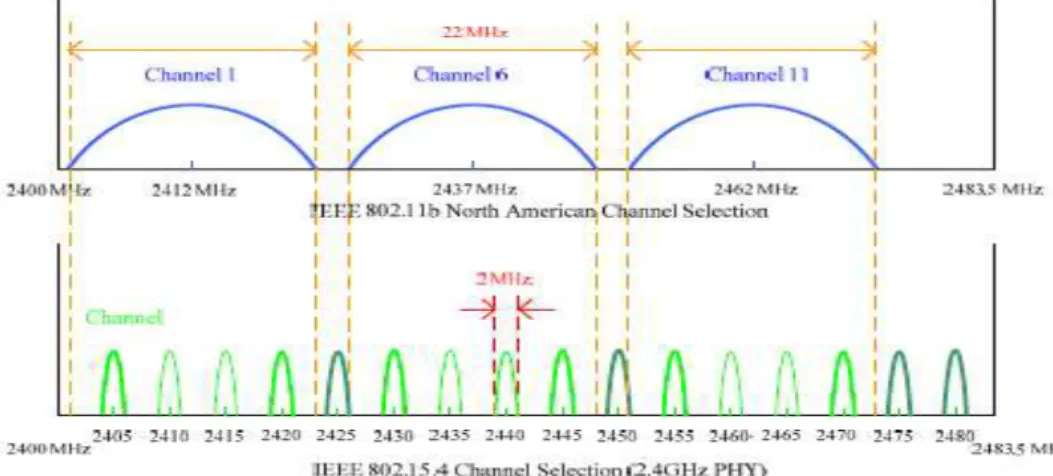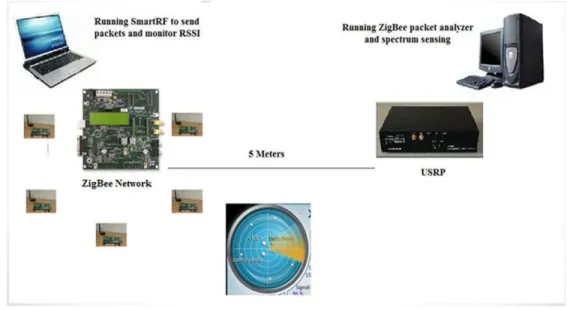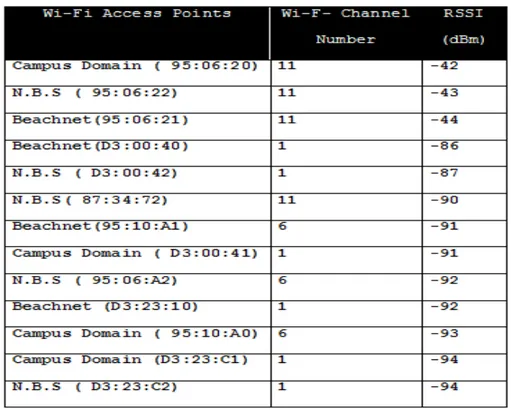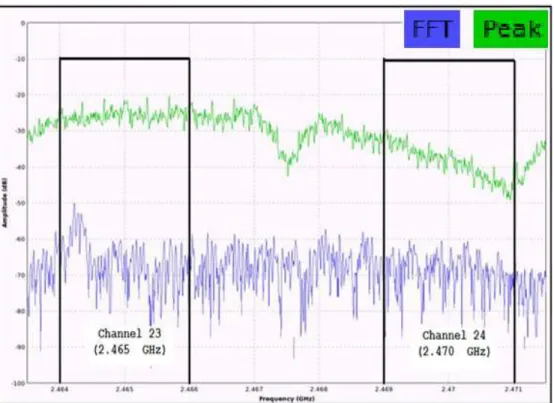DOI : 10.5121/ijdps.2011.2401 1
!
Dr. Tulin Mangir, Lelass Sarakbi, Harvy Younan
temangir@csulb.edu; lsarakbi@csulb.edu; Harvy.Younan@student.csulb.edu
Abstract
The increase of ZigBee popularity and usage in different home area networks exert a new challenge for operating ZigBee in an environment that is already using Wi-Fi. Sharing the spectrum between these two wireless technologies affect the functionality of Zigbee as it may cause a high packet error rate and major drop in the throughput.
In this paper we studied the effect of Wi-Fi interference on ZigBee channels by using the Cognitive Radio as Spectrum Analyzer [1], [1], [3] and computed the packet error rate (PER) of each of the ZigBee channels. The results that we have obtained contradict the previous analytical and simulation results in which the effect of Wi-Fi on ZigBee has been studied [4], [5], [6].
In the previous works, the authors assumed that the in-band interference signal of the Wi-Fi is a limited Adaptive White Gaussian Noise (AWGN). Therefore their results were based only on the interference level on each of the ZigBee channels. While in this paper, we prove that the aforementioned assumption does not hold in all cases. Therefore the obtained results are based on the interference level and distribution on each of the ZigBee channels.
Keywords
ZigBee, Wi-Fi, interference, experimental analysis, coexistence.
1. Introduction
ZigBee is one of the most common wireless technologies used for home automation in Home Area Network (HAN) [7], [8]. Unlike other wireless technologies, ZigBee is a low power, low data rate wireless protocol that allows a long battery life for operated devices. The significant use of ZigBee devices is its ability to change the state of the device for example; we can control the door locks, change the temperature of a thermostat, and turn on and off the fire alarms.
ZigBee operates in the unlicensed 2.4 GHZ band which is the band that is shared among major wireless standards which are Wi-Fi and Bluetooth [9], [10], [11], [12].
Due to the increasing number of devices and systems that operate in the 2.4 GHz band, interference among these systems becomes complex in nature. Wi-Fi, Bluetooth, and cordless phones are considered the broadest systems in the 2.4 GHz band, in addition to the other no networking systems such as microwave ovens, which may radiate electromagnetic radiation in the 2.4 GHz band. As a result of the non-proprietary characteristic of the 2.4 GHz license free band, resource planning or bandwidth allocation cannot be assured.
2 radiation on ZigBee from the microwave oven is acceptable only if the distance between them is in range of a few meters.
Perhaps, it is essential for these technologies to coexist with minimal interference effect on each other. The overlapping channels between 802.11 and 802.15.4 are shown in figure. 1, which shows channel 15, 20, 25, and 26 are of minimal interference. Despite different efforts to minimize the effect of interference, the two communication technologies that are transmitting at different power levels and having different characteristics interfere with each other.
The coexistence of Wi-Fi and ZigBee exerts a serious challenge for operating the two technologies in the same environment. Sharing of the spectrum between these technologies raise serious problems, which lead to a degradation of performance, dropping of packets, decreasing of the throughput and malfunctioning of the whole ZigBee network. Perhaps, the interference that is caused by 802.11 networks would last from several minutes to several hours, hence, causing a huge packet loss in ZigBee network. The interference could threaten the security and
the functionality of the network.
Figure 1. WIFI and Zigbee Overlapping Channels in The 2.4Ghz ISM Band
In this context, profound knowledge of the spectrum occupation of both technologies is needed to better study the effects of interference in order to minimize it [19], [20], [21], [22], and [23]. In this paper, we focus on analyzing the impact of interference that Wi-Fi produces on ZigBee networks using the CC2430 ZigBee Development Kit and the cognitive radio [24], [25], [26], [27]. Cognitive radio acts as a spectrum analyzer and it is used to implement the physical (PHY) and media access control (MAC) layers of the IEEE802.15.4 nodes [28], [29], [30]. Cognitive radio is used for detecting the interference and analyzing the spectrum allocation of different ZigBee and Wi-Fi channels under different conditions.
3 assumption doesn’t always apply for all ZigBee channels that overlap with Wi-Fi channels as it has been proven in this paper.
In part two of this paper, the methodology of different experiments that are performed is explained. The first experiment is the ideal operation of ZigBee under no Wireless Interference .This experiment is used as a base line for the following experiments. In experiment two, the environment is a laboratory with 14 access points (noisy environment) operating with different receiver signal strength indication (RSSI). In experiment three, the interference of one Access point is studied. The results are also shown in part two and an analysis of the results is discussed in part three. Finally, the conclusion of this work is presented.
2. Methodology
A set of experiments are performed in different environments (indoor, outdoor, noisy, and noise free) in which we studied the coexistence between the two major communication technologies (Wi-Fi and ZigBee). The first test was performed in a parking lot where there is no wireless signal coverage. It is used as the baseline for the noise level and PER for each ZigBee channel in order to compare the following experiments with this ideal case. The second experiment is performed in an indoor noisy environment where there are different Access Points with differ RSSI. The third experiment is performed in an outdoor environment with interference from one access point on channel 6. Our analysis is mainly focused on studying the interference versus RSSI, packet error rate and the offset frequency between ZigBee and Wi-Fi.
Figure 2. Experiments’ Topology
2.1 Experiment One
The purpose of experiment one is to test the behavior of ZigBee channels in an ideal case where there is no wireless signal presence. The average noise level of all ZigBee channels was detected and it turned out to be that it is -62 dB with respect to a 45 dBm gain used by ZigBee Spectrum Analyzer.
4 This experiment is used as a baseline for the following two experiments. It shows ZigBee behavior with no interference from any wireless technology operating on the same frequency band.
2.2 Experiment Two
As shown in table 1, there are different access points operating in the laboratory environment. However, there are 3 main channels that are being used by the Wi-Fi which are Channel 1, 6 and 11.
To study the effect of channel 1 on ZigBee channels, we have detected from figure 1, the overlapping channels which are channels 11, 12, 13, and 14. The same applies for channel 6 and 11. For channel 6, the overlapping ZigBee channels are 16, 17, 18, and 19. For Channel 11, the overlapping ZigBee Channels are 21, 22, 23, and 24. The non-overlapping channels between ZigBee and Wi-Fi are 15, 20, 25, and 26.
Table 1. Wi-Fi Access Points Operating Channels and RSSI
As shown in table1, the received signal of channel 1 is weak (between -87 and -94). Under the effect of low traffic , the packet error rate of the channels that are on the edge ( 3% and 5% ) are higher than the ones that are very close to the center frequency (2% and 3%) . The received signal of channel 6 is very weak (between -91 and -93), and under the effect of low traffic, as well; the packet error rate of the overlapping channel 14 is 0% whereas the overlapping channel 17, 18 and 19 is 2%. The received signal of channel 11 is high (between -42 and -44) , and under the effect of high traffic; the packet error rate of edge channels 21 and 24 is 94% and 100% respectively, whereas channels 22, and 23 which are closer to the center frequency are 49% and 20%.
5 Table 2. Packet Error Rate of ZigBee Channels (Experiment Two)
2.3 Experiment Three
This experiment is performed in a non noisy environment. However, it is focused on creating an interference using only one Wi-Fi access point that is operating on channel 6. Channel 6 overlaps with channels 16, 17, 18, and 19.
The received signal of channel 6 is high (-38 dB). The packet error rate of the edge channels 16 and 19 are 98.5 and 98.6 respectively, whereas the channels 17 and 18 which are closer to the center frequency are 41.7% and 27.5%.
3. Discussion
Theoretically, the expected results of the PER percentage of the ZigBee channels that are overlapping with Wi-Fi channels should have a low percentage on the edge channels and higher percentage on the channels that are close to the center frequency .As the distribution of power is concentrated around the center frequency and degrades as we go away from the center (edges).
6 Figure 3. Interference Signal on ZigBee Channels 25 and 26 of Experiment Two
7 Figure 5. Interference Signal on ZigBee Channels 23 and 24 of Experiment Two
8 By investigating the noise level of each channel separately, as shown in fig. 3 and 4, Channel 22 which operates on 2.46 GHz with bandwidth 2MHz, shows that the interference level is equally distributed all over the bandwidth with low fluctuation, which is similar to the white Gaussian noise characteristics. The same behavior applies for channel 23 which operates on 2.65 GHz with bandwidth 2MHz. However , Channel 21 which operates on 2.455 GHz ,and channel 24, which operates on 2.470 GHz have lower interference level compared to channel 22 and 23 .The interference on channel 21 and 24 is not equally distributed all over the bandwidth and it has a high fluctuation which is in a way different than the white Gaussian noise characteristics. The PERs on channels 22 and 23 are less than the PERs on channels 21 and 24 because most of the communication systems consider the characteristics of the white Gaussian noise in their receiver designs to successfully retrieve the transmitted signal. In addition, the estimated energy level by the clear channel assessment (CCA) algorithm doesn’t reflect real time interference level on channels 21 and 24.
The CCA algorithm is used by ZigBee as a part of the carrier sense multiple access (CSMA) algorithm to detect and estimate the energy level on the operating channel based on the average of 8 symbol periods (128 µs) [9], [11].
4. Conclusion
The interference effect of the Wi-Fi signals on ZigBee channels has been investigated based on real experiments in different levels of noisy wireless environment. The PER is used as an indicator to evaluate the sixteen ZigBee channels in the 2.4 GHz ISM band.
The interference effect of the Wi-Fi signals on ZigBee channels has been investigated based on real experiments in different noisy wireless environments. The PER and the interference level and distribution are used as indicators to evaluate the sixteen ZigBee channels in the 2.4 GHz ISM band.
For each Wi-Fi channel, there are four overlapping ZigBee channels, two channels at the edges and two close to the center frequency of the Wi-Fi channel. In fact, the interference level on the two channels close to the center is higher than those on the edges. However, the PER on the edges channels is much higher (close to 100%, in case of heavy traffic or close to the access point) than those channels close to the center.
The obtained results contradict the previous result presented in [4], [5], and [6]. The results of those papers were mainly based on simulation and analytical analysis, in which they showed that the PER increased as we got closer to the center frequency of Wi-Fi channel.
The articulated assumption in the previous work is that the in-band interference power of Wi-Fi is considered as a band-limited AWGN for ZigBee. This assumption is correct in the case of center channels and fails in the case of edge channels. This is because the interference distribution of the edge channels is totally different than AWGN.
CCA algorithm fails to estimate the actual energy on the edge channels, because CCA ignores the distribution of the interference on the operating channel.
References
[1] Mukul Anil KhairatKar, "Building Cognitive Radio for physical Layer Intrusion Detection," California State University of Long Beach, August 2009.
[2] Tulin Mangir ,Mukul KhairatkarCalifornia State Univ "Network Access Security Policies for Cognitive radio," SDR '08, Washington, D.C. Oct. 26-30, 2008.
9 [4] Soo Young Shin, Hong Seong Park, Sunghyun Choi and Wook Hyun Kwon, "Packet Error Rate Analysis of ZigBee Under WLAN and Bluetooth Interferences," Wireless Communications, IEEE Transactions on, vol. 6, pp. 2825-2830, 2007.
[5] Soo Young Shin, Jeong Seok Kang and Hong Seong Park, "Packet error rate analysis of ZigBee under interferences of multiple bluetooth piconets," in Vehicular Technology Conference, 2009. VTC Spring 2009. IEEE 69th, 2009, pp. 1-5.
[6] Guang Yang and Yu Yu, "ZigBee networks performance under WLAN 802.11b/g interference," in Wireless Pervasive Computing, 2009. ISWPC 2009. 4th International Symposium on, 2009, pp. 1-4. [7] E. Callaway, P. Gorday, L. Hester, JA Gutierrez, M. Naeve, B. Heile, and V. Bahl, " Home networking with IEEE 802.15. 4: a developing standard for low-rate wireless personal area networks," Communications Magazine, IEEE, 40(8):70–77, 2002.
[8] J.A. Gutierrez, E. Callaway, et al, " Low-Rate Wireless Personal Area Networks: Enabling Wireless Sensors with IEEE 802. 15. 4, "Institute of Electrical & Electronics Engineers, 2003.
[9] IEEE, Ieee 802.15.4-2006 standard, http://standards.ieee.org/getieee802/download/802.15.4-2006.pdf, 2006.
[10] S. Farahani and I. Books24x7, ZigBee Wireless Networks and Transceivers. Burlington, Mass.: Newnes/Elsevier, 2008.
[11] D. Gislason and I. Books24x7, Zigbee Wireless Networking. Burlington, Mass.: Newnes/Elsevier, 2008.
[12] A. Elahi and A. Gschwender, ZigBee Wireless Sensor and Control Network. Upper Saddle River, N.J.: Prentice Hall, 2010.
[13] Dong Yang, Youzhi Xu and M. Gidlund, "Coexistence of IEEE802.15.4 based networks: A survey," in IECON 2010 - 36th Annual Conference on IEEE Industrial Electronics Society, 2010, pp. 2107-2113. [14] Hongwei Huo, Youzhi Xu, C. C. Bilen and Hongke Zhang, "Coexistence issues of 2.4GHz sensor networks with other RF devices at home," in Sensor Technologies and Applications, 2009. SENSORCOMM '09. Third International Conference on, 2009, pp. 200-205.
[15] N. H. Mahalin, H. S. Sharifah, S. K. S. Yusof, N. Fisal and R. A. Rashid, "RSSI measurements for enabling IEEE 802.15.4 coexistence with IEEE 802.11b/g," in TENCON 2009 - 2009 IEEE Region 10 Conference, 2009, pp. 1-4.
[16] S. Pollin, I. Tan, B. Hodge, C. Chun and A. Bahai, "Harmful coexistence between 802.15.4 and 802.11: A measurement-based study," in Cognitive Radio Oriented Wireless Networks and Communications, 2008. CrownCom 2008. 3rd International Conference on, 2008, pp. 1-6.
[17] K. Shuaib, M. Boulmalf, F. Sallabi and A. Lakas, "Co-existence of zigbee and WLAN, A performance study," in Wireless Telecommunications Symposium, 2006. WTS '06, 2006, pp. 1-6. [18] Wenqi Guo, W. M. Healy and Mengchu Zhou, "An experimental study of interference impacts on ZigBee-based wireless communication inside buildings," in Mechatronics and Automation (ICMA), 2010 International Conference on, 2010, pp. 1982-1987.
[19] T. Yucek and H. Arslan, "A survey of spectrum sensing algorithms for cognitive radio applications," Communications Surveys & Tutorials, IEEE, vol. 11, pp. 116-130, 2009.
10 [21] E. Axell, G. Leus and E. G. Larsson, "Overview of spectrum sensing for cognitive radio," in Cognitive Information Processing (CIP), 2010 2nd International Workshop on, 2010, pp. 322-327. [22] Weifang Wang, "Spectrum sensing for cognitive radio," in Intelligent Information Technology Application Workshops, 2009. IITAW '09. Third International Symposium on, 2009, pp. 410-412. [23] M. A. Sarijari, A. Marwanto, N. Fisal, S. K. S. Yusof, R. A. Rashid and M. H. Satria, "Energy detection sensing based on GNU radio and USRP: An analysis study," in Communications (MICC), 2009 IEEE 9th Malaysia International Conference on, 2009, pp. 338-342.
[24] R. C. Qiu, Z. Chen, N. Guo, Y. Song, P. Zhang, H. Li and L. Lai, "Towards a real-time cognitive radio network testbed: Architecture, hardware platform, and application to smart grid," in Networking Technologies for Software Defined Radio (SDR) Networks, 2010 Fifth IEEE Workshop on, 2010, pp. 1-6.
[25] Song Wenmiao, "Configure cognitive radio using GNU radio and USRP," in Microwave, Antenna, Propagation and EMC Technologies for Wireless Communications, 2009 3rd IEEE International Symposium on, 2009, pp. 1123-1126.
[26] GNURadio, Exploring gnu radio and the usrp, http://www.gnu.org/software/gnuradio/doc/exploring-gnuradio.html, 2004.
[27] Matt Ettus. Universal software radio peripheral. http://www.ettus.com, 2009
[28] Schmid, T. "Gnu radio 802.15.4 en- and decoding analyzer,” NESL Technical Report, 2006
[29] 'Leslie Choong', " Multi-channel IEEE 802.15.4 packet capture using software defined radio," UCLA Networked & Embedded Sensing Lab, 03 2009.




